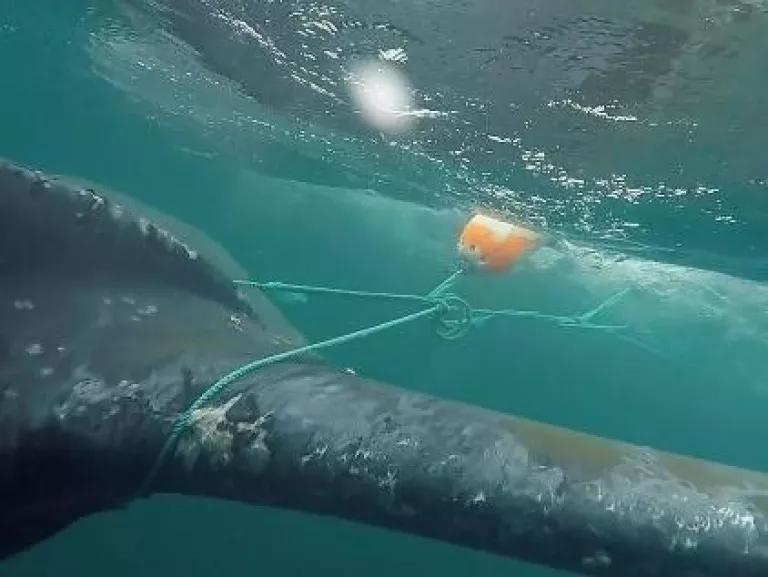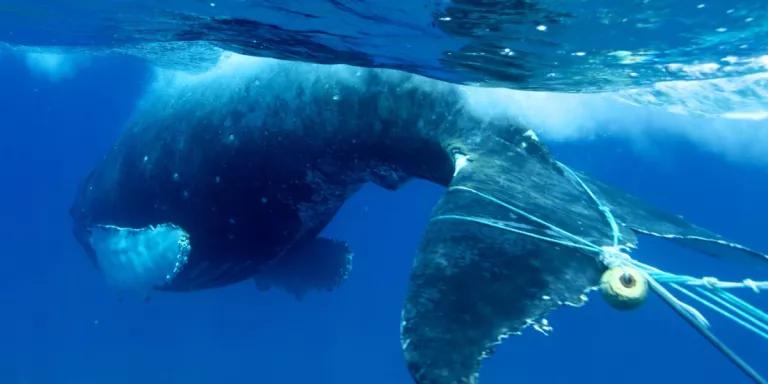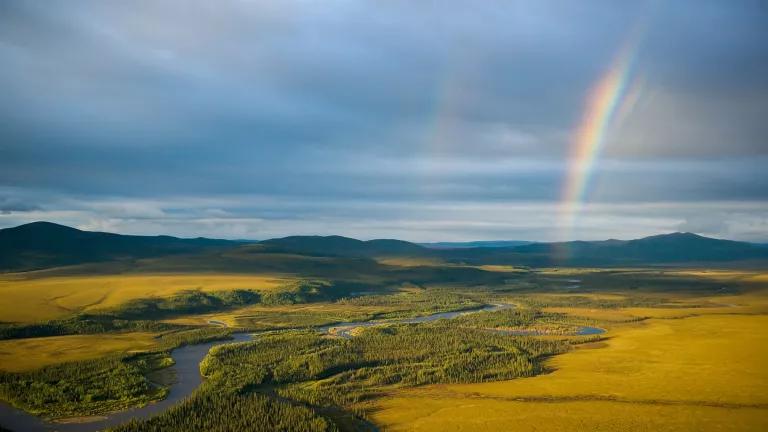Tackling a Threat: Whale Entanglement on the West Coast
West Coast whale entanglements are increasing and threatening many whale species off the U.S. coast—but a solution is within reach.

Gray whale
Whales are one of the most important and awe-inspiring species that call our oceans home. Ranging from the frigid waters of the poles to the tropical waters of the equator; whales are an icon of our ocean’s abundant life, health, and beauty. Yet, hidden beneath the surface these animals are in an unseen fight for their lives.
Whales are being entangled by fishing gear off California’s coastline more than ever before. These serious entanglements happen most often when whales encounter the vertical ropes connecting buoys on the surface to crab, lobster or spot prawn traps on the ocean floor. It’s common for whales to hit a line with their long appendages or catch these ropes across their mouths.
Entanglement in these ropes is deadly for whales. Many drown almost immediately as they are pulled below the surface, others suffer for weeks or even years with the ropes chafing into their skin, muscle, and bone. Dragging heavy fishing gear leaves whales exhausted, starved, and can lead to them suffering a slow and painful death. It can also hinder their ability to reproduce successfully.


46 whales were confirmed as entangled in fishing gear off the West Coast in 2018 alone. Of these, 30 were seen and reported in California, 12 in Washington, and three in Oregon. One additional report was from Baja, Mexico, where a whale was entangled in gear originating from the United States.
These whales were entangled in a mix of fishing gear which included commercial Dungeness crab gear, commercial and recreational spot prawn gear, as well as commercial and tribal gillnets. Only 26 whales were entangled in gear that was identified as coming from specific fisheries or gear types, with the other 20 whales entangled in gear that was not tied to a specific source.
While 46 individual whales already seem like too many, the sad reality is that there are an unknown number of entangled whales that go unnoticed by humans, sink into the sea, and ultimately lose the fight for their lives.
As seen in the Figure below, humpback whales continue to be the most common West Coast species entangled with 34 separate entanglements confirmed in 2018. There were 11 gray whales, and one fin whale also confirmed as entangled in 2018.

Figure 1. Confirmed U.S. West Coast whale entanglements by year and species, 2000 to 2018.
The International Whaling Commission identifies entanglements as the main human-caused threat to large whales, estimating that 300,000 whales, dolphins, and porpoises die from entanglement each year worldwide. Entanglement impacts a host of other marine life on top of large whales both big and small.
On the East Coast, entanglement is now the number one cause of death for the North Atlantic right whale and is driving the species to extinction. If action is not taken soon, many of our California whale species; like the humpback, and gray whale, may follow the North Atlantic right whale’s trajectory.
While the underlying cause of the increase in whale entanglements on the West Coast is subject to further analysis, climate change could be a leading driver.
According to the International Union for Conservation of Nature (IUCN), increasing carbon dioxide (CO2) and other greenhouse gas emissions (GHG) cause increases in water temperature, ocean acidification, and deoxygenation, impacting the diversity and abundance of marine species.
In 2019, more than 120 gray whale strandings occurred along the west coast of North America. Because of the skinny and emaciated forms of many of the stranded whales, scientists speculate that climate change and changes in the whale’s food supplies could be one of the reasons behind these whales’ unusual mortalities. Whales are being forced to visit areas they don’t normally visit as they migrate along the west coast in search of food. This exploration into new areas likely brings them into contact with more fishing line than normal, leading to more entanglements.
Whales are dealing with the forefront of what climate change can do to our ecosystems and being entangled in fishing ropes is something that only adds to the threats these animals face. We must work to reduce entanglements and other stressors that affect whales as they deal with changing waters and a changing ocean.
The solution: Ropeless (or “pop-up” fishing gear)
Tackling a problem as large as whale entanglement is a daunting task and will take a lot of work from many different groups and people. Thankfully, there are many technologies and ideas under development to stop entanglements from happening. One such technology is ropeless fishing gear.
“Ropeless” or “pop-up” gear is a solution with a simple premise and huge implications for conservation. This technology allows the rope—normally connecting a buoy at the surface to a trap at the ocean floor—to be stored on the ocean floor alongside the trap. By storing the gear on the ocean floor while waiting for a trap to attract its intended prey, the time that a line is in the water is greatly reduced. To retrieve their ropeless gear, the fisher then sends an acoustic signal—like remotely opening a car door—to the device to release the rope and the buoy to the surface where the fisher immediately removes it.
Transitioning traditional line and buoy systems to ropeless systems can bring huge benefits for the protection of whale species all along the West Coast.

An illustration showing only a few ropeless fishing solutions that help prevent the entanglement of whales.
Tests show that there is great potential for this gear to reduce entanglements in the Dungeness crab fishery. In the late spring of 2018, three California crab fishermen participated in an initial trial of ropeless fishing gear. The fishermen tested two different ropeless systems and used the ropeless system to deploy and retrieve their equipment and pots off the coast of California. This was a great first step that highlighted that more testing must happen to make these technologies trackable and ready for deployment at a commercial scale.
There is some positive momentum in California for whales. California’s Ocean Protection Council (OPC) has recently adopted an investment strategy to minimize whale and sea turtle entanglement in fishing gear off California waters. This plan includes pursuing the best available science, advancing collaboration among all parties involved, improving outreach and response efforts to entangled whales, and supporting the research and development of gear innovations that will reduce the risk of entanglement. The OPC has approximately $5.3 million to address these priorities while working to reduce entanglements.
The OPC can, therefore, pave the way for huge advancements and innovative changes that will prevent entanglements and save the whales in California's waters for generations to come.
What NRDC is advocating for
We are advocating for the OPC to prioritize funding a large-scale field trial of ropeless gear evaluating the commercial feasibility of the technology as a long-term entanglement solution. Developing electronic tracking systems that allow for gear detection and protect sensitive business information is also critical. This technology will help prevent potential gear conflicts among fishermen and enable enforcement.
Take action and help us protect our marine species from entanglement! Check out how you can help make a change:
- Reach out to the Ocean Protection Council and share a comment on why you believe we should fund and research solutions to whale entanglement.
- Reach out to your state representative and ask them to support endeavors to protect our marine species from entanglement. To find your state representative go HERE.
- Educate your friends and family about the issue. With more people informed about the issue, the more change that will happen. Learn more about whale entanglement and other issues on NRDC’s Expert’s Blog Pages.
- If you see an entangled whale off California’s coast, call (877) SOS-WHALE (877–767–9425) or hail the U.S. Coast Guard on VHF CH-16.


